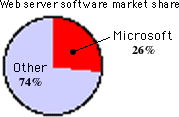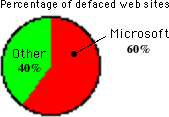
sponsored by
 sponsored by |
 | OSdata.com |
Combines Windows NT/2000 professional series with the Windows 98/ME consumer series into a single operating system. Uses a graphic look similar to Apple’s Mac OS X in order to confuse and mislead customers into thinking that Windows XP has similar reliability, security, ease of use, and performance. Windows XP includes a copy protection scheme that may prevent adding or replacing any hardware unless the user obtains a new activation code directly from Microsoft. News articles report demands for a Microsoft-provided activation code when a user has installed software from one of Microsoft’s competitors or even apparently just by “whim” when nothing has been changed.
“There may have been some confusion as to what Microsoft’s Activation does and does not do back when Windows XP was first released, but give me a break, that statement strays far off the path of a site supposedly giving factual information on operating systems. The activation program will only force a person to reactivate upon severe HARDWARE changes (thus, Windows can’t tell its on the same computer anymore). It has NOTHING to do with software or any kind of anti-competitive scheme. Reactivation will NOT be necessary for ANY software changes, period. I would correct that statement if you hope to maintain a site that people regard as unbiased. Thank you.” —Davison Long, via e-mail, 13 Sept 2002e131
OSdata.com is used in more than 300 colleges and universities around the worldFind out how to get similar high web traffic and search engine placement. |
Intended purpose
server/mainframe: Microsoft intends Windows XP for server use (but it is the least secure, most hacked, and least powerful of all server operating systems)
desktop/workstation: Microsoft intends Windows XP for workstation and desktop use
handheld: not appropriate
real time: not appropriate
Kind of OS: proprietary
Release Date: 2001
Current Version:
Hardware Supported: Intel/Cyrix/AMD Pentium
Maximum Number of Processors: varies
Windows XP will run on 64 bit processors, but it isn’t a 64-bit OS because it only has 32-bit addressing.
Kernel: proprietary (microkernel)
POSIX: partially supported
“Windows XP is better than earlier versions, but the Windows world is a cacophony of computer makes and models, making compatibility glitches inevitable. The frustration Windows users often experience is reflected in a clickable link I found in Windows XP’s online help: ‘I still can’t scan.’ ” —Jim Heid, “A Study in Contrasts”, Los Angeles Times, March 2002n4
Text Command Shell: DOS command line
Graphic Command Shell: Explorere80
“Microsoft has blundered by burdening Windows XP with frequent sales pitches for Microsoft products and services. Getting started with Windows XP is like watching network TV: The show isn’t bad, but the commercials are annoying.
“If Windows XP feels like ABC, Mac OS X feels like HBO.” —Jim Heid, “A Study in Contrasts”, Los Angeles Times, March 2002n4
Disabled support: none
 |
 |
| Market share as of January 2002 | Defacements = about 30,000 between April 2000 and February 2002 |
| Microsoft software runs about a quarter of Web servers, but is the target of the majority of successful Web defacement attacks. —Los Angeles Times, February 13, 2002n3 | |
“As Windows users are being plagued by computer viruses, spam, buggy software, and Web pop-up ads, some are questioning why the Redmond, Wash.-based software behemoth has failed to integrate security and repair features that could make computers less prone to problems.
“ ‘Microsoft has added lots of bells and whistles to Windows to protect their operating system franchise over the years, but when it comes to Windows security and reliability, they’ve done comparitively little until recently,’ said Alan Paller, director of research at the SANS Institute, a Bethesda, Md.-based computer security and training organization.
“ ‘It’s like they are selling faster cars with more powerful engines but leaving off the seat belts and air bags — all those critical things that make customers safe when using their products,’ he added.
“Microsoft’s critics say the reason the company isn’t eager to add security features is simple: Doing so wouldn’t help it fend off competitors whose products could undermine the spread of Windows.
“ ‘You would think there would be money to be made in Microsoft having some kind of more effective antiviral program of their own,’ said Andrew Gavil, an antitrust expert and law professor at Howard University. ‘But virus programs don’t present any threat to their operating system monopoly.’ ” —Los Angeles Times, “Microsoft Runs Into Bundling Dilemma”, March 27, 2004n4
Microsoft falsely claimed that it would make security a company-wide priority in its much publicized 2002 “trustworthy computing initiaitve”. Since then, Microsoft Windows (all versions) has become even more vulnerable to viruses and other internet attacks. Security is a purposely false and misleading marketing slogan at Microsoft.
“Ironically, some experts say, product bundling is partly to blame for Windows’ security woes.
“Lee A. Hollaar, a computer science professor at University of Utah, said the widespread proliferation of the Melissa computer virus stemmed from the tight integration of Microsoft’s Outlook e-mail program with its writing application, Word.
“ ‘The Melissa virus exists only because Microsoft expanded Word documents to contain functions that let it access the Outlook address book’, Hollaar said.
“Similarly, he explained, when the Internet Explorer Web browser was folded into the operating system, it exposed Windows to greater security risks from the Net.’ ” —Los Angeles Times, “Microsoft Runs Into Bundling Dilemma”, March 27, 2004n4
Other:
Ethics: Bill Gates is a longtime member of the Augusta National Golf Club, the official site of the Masters Golf Tournament. The Augusta National Golf Club refuses to allow any women join their club and for decades refused to allow Blacks, Hispanics, and other minorities to join, only relenting in 1990 to allow a few token Black members when facing criminal charges for Civil Rights violations. The only reason that Microsoft hires women and minorities is because of tough federal Civil Rights laws. If you are a woman, Black, Hispanic, Asian, or a member of any other minority group, remember that Bill Gates and Microsoft hate you and only take your money becuase they are forced to by law.
opinion
“The future of Windows is threatened less by the superiority of its competition than the inferiority of Windows, which results from Microsoft’s misplaced priorities. Microsoft’s design decisions are driven more by its attempt to protect its desktop monopoly than by technical excellence.” —Nicholas Petreley, “The new Unix alters NT’s orbit”w74

1.1 MB QuickTime movie of Bill Gates explaining his criteria for selecting the best operating system.
“Microsoft enjoyed its great success not because it had great software but because people were stuck with it. Market domination, not innovation, drove the company’s success,” wrote James Wallace in the book “Overdrive: Bill Gates and the Race to Control Cyberspace”, John Wiley & Sons, September 1997.
“Windows machines have advantages, too, such as more configuration options, cheaper up front cost, availability of software, snappier response on window controls, cheaper components, more peripherals.” —Why Monopolies Are Bad, by Jeff Adkinsw77
Commentary: Quite simply, Windows guarantees more work for the M.I.S. departments — because it computers require far more technical support to do the same work. And when the M.I.S. departments make computer recommendations to management, they tend to look out for their own job security over the best interests of the business. The same reason that many retail stores also push Wintel machines — it guarantees more work for their highly profitable service departments.
“I use both Macs and Windows XP computers daily, and the Mac is less frustrating, less commercially intrusive, and more elegant. Quite simply, it’s a better computer.” —Jim Heid, “A Study in Contrasts”, Los Angeles Times, March 2002n4
In addition to ![]() Macintosh OS X (formerly
Macintosh OS X (formerly ![]() Rhapsody) (which combines the ease of use and professional content creation capabilities of the
Rhapsody) (which combines the ease of use and professional content creation capabilities of the ![]() Macintosh with the power, reliability, and speed of the
Macintosh with the power, reliability, and speed of the ![]() NeXT version of UNIX),
NeXT version of UNIX), ![]() BeOS, NetWare, and
BeOS, NetWare, and ![]() OS/2 Warp Server, any of the many free and commercial versions of UNIX offer a better high end operating system than Windows 2000. See John Kirch’s article “Microsoft Windows NT Server 4.0 versus UNIX” at http://www.unix-vs-nt.org/.
OS/2 Warp Server, any of the many free and commercial versions of UNIX offer a better high end operating system than Windows 2000. See John Kirch’s article “Microsoft Windows NT Server 4.0 versus UNIX” at http://www.unix-vs-nt.org/.
Serious commercial UNIXs include: AIX, Digital UNIX, ![]() HP-UX,
HP-UX, ![]() IRIX,
IRIX, ![]() Macintosh OS X, Mac OS X Server(formerly
Macintosh OS X, Mac OS X Server(formerly ![]() Rhapsody), and
Rhapsody), and ![]() Solaris.
Solaris.
Leading free UNIXs include: ![]() FreeBSD,
FreeBSD, ![]() GNU Hurd,
GNU Hurd, ![]() LINUX,
LINUX, ![]() NetBSD, and
NetBSD, and ![]() OpenBSD.
OpenBSD.
And in the server arena, the leader is still NetWare.
“Randy Kessell, manager of technical analysis for a Southwestern Bell operation center, notes that because Linux allows his company to do more remote network administration and software loads than was possible with either Microsoft or NetWare products, it has driven down their network management costs.” —Ann Harrison, “In LINUX We…”, Software Magazine, Cover Story, September 1998w51
![]() Study after study has shown that Macintoshes are less expensive to support and maintain than Wintel machines. Wintel computers typically cost four to 10 times as much in support costs. Even Intel’s own internal study showed that it was costing them four times as much to support Windows machines as it did to support their Macintoshes (yes, Intel used Macintoshes for mission critical work — and since that study they have been expanding their use of Macintoshes).
Study after study has shown that Macintoshes are less expensive to support and maintain than Wintel machines. Wintel computers typically cost four to 10 times as much in support costs. Even Intel’s own internal study showed that it was costing them four times as much to support Windows machines as it did to support their Macintoshes (yes, Intel used Macintoshes for mission critical work — and since that study they have been expanding their use of Macintoshes).
![]()
![]()
![]() Independent studies over the years continually show that worker productivity is substantially higher on Macintoshes than on Wintel computers. And the difference is greatest in the creative fields (pre-press, illustration, digital photography, 2-D and 3-D animation, 3-D modelling and rendering, film special effects, broadcast video editting, CD-ROM production, multi-media, music composition and performance, sound editting, and web site production), where the Macintosh is the most prevalent computer (even more than the high end graphics work stations — and Macintosh OS X (formerly Rhapsody) brings the Macintosh to the high end graphics work stations). Macintosh OS X is numerically the most used form of
Independent studies over the years continually show that worker productivity is substantially higher on Macintoshes than on Wintel computers. And the difference is greatest in the creative fields (pre-press, illustration, digital photography, 2-D and 3-D animation, 3-D modelling and rendering, film special effects, broadcast video editting, CD-ROM production, multi-media, music composition and performance, sound editting, and web site production), where the Macintosh is the most prevalent computer (even more than the high end graphics work stations — and Macintosh OS X (formerly Rhapsody) brings the Macintosh to the high end graphics work stations). Macintosh OS X is numerically the most used form of
See also: http://www.unix-vs-nt.org/, John Kirch’s article “Microsoft Windows NT Server 4.0 versus UNIX”
(for your convenience, look for this symbol ![]() marking passages about Windows XP)
marking passages about Windows XP)
Please send recommendations on additional URLs to Milo.
(Frequently Asked Questions)
If you want your book reviewed, please send a copy to: Milo, POB 1361, Tustin, CA 92781, USA.
Price listings are for courtesy purposes only and may be changed by the referenced businesses at any time without notice.
1 Microsoft Way: A Cookbook To Breaking Bill Gates Windows Monopoly Without Breaking Windows (with Linux CD Operating System); by Reginald P Burgess; American Group Publishing; April 27, 1998; ISBN 1891950088; paperback; 208 pages; $17.95
Universal Command Guide; by Guy Lotgering (UCG Team); Hungry Minds, Inc; April 2002; ISBN 0764548336; hardcover with CD-ROM; 1,600 pages; $69.99; cross references all of the commands from: AIX; Solaris; RedHat Linux; Berkeley BSD; NetWare 3.2, 4.11, 5, and 6; DOS 6.22; Windows 95, 98, ME, XP, NT 4 Workstation, NT 4 Server, NT 4 Terminal Server, 2000 Professional, 2000 Server, 2000 Advanced Server; Citrix Mainframe 1.8; and Mac 9
![]()
If you want your book reviewed, please send a copy to: Milo, POB 1361, Tustin, CA 92781, USA.
OSdata.com is used in more than 300 colleges and universities around the world |
| Tweets by @osdata |
A web site on dozens of operating systems simply can’t be maintained by one person. This is a cooperative effort. If you spot an error in fact, grammar, syntax, or spelling, or a broken link, or have additional information, commentary, or constructive criticism, please e-mail Milo. If you have any extra copies of docs, manuals, or other materials that can assist in accuracy and completeness, please send them to Milo, PO Box 1361, Tustin, CA, USA, 92781.
If you have an extra or unwanted copy of any official manuals or documentation on this operating system, please send them to: Milo, POB 1361, Tustin, CA 92781, USA. I have the following items: NONE.
Note: I am looking for a fan of Windows XP who has the time to check this web site for completeness and accuracy regarding Windows XP. Just check through the site about once a week or so and report back with any information (including the URL of the web page you are reporting).
Click here for our privacy policy.
Click here to skip over the summaries of individual operating systems.
| previous page | next page |
Digital UNIX (or DUNIX) |
||
|
||

This web site handcrafted on Macintosh ![]() computers using Tom Bender’s Tex-Edit Plus
computers using Tom Bender’s Tex-Edit Plus ![]() and served using FreeBSD
and served using FreeBSD ![]() .
.
†UNIX used as a generic term unless specifically used as a trademark (such as in the phrase “UNIX certified”). UNIX is a registered trademark in the United States and other countries, licensed exclusively through X/Open Company Ltd.
Names and logos of various OSs are trademarks of their respective owners.
Copyright © 2002, 2003, 2004 Milo
Last Updated: March 27, 2004
Created: January 14, 2002
Click here to skip over the summaries of individual operating systems.
| previous page | next page |